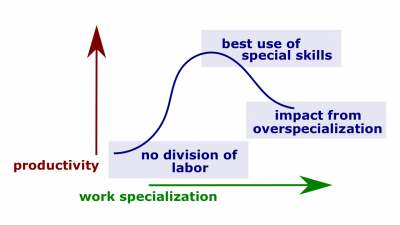Difference between revisions of "Work specialization"
(→Related coursework) |
MariamKhalid (talk | contribs) |
||
| Line 6: | Line 6: | ||
According to [[Organizational Behavior by Robbins and Judge (17th edition)]], | According to [[Organizational Behavior by Robbins and Judge (17th edition)]], | ||
:[[Work specialization]]. The degree to which tasks in an [[organization]] are subdivided into separate jobs. | :[[Work specialization]]. The degree to which tasks in an [[organization]] are subdivided into separate jobs. | ||
| − | + | According to [[Management by Robbins and Coulter (14th edition)]], | |
| + | :[[Work specialization]]. Dividing work activities into separate job tasks. | ||
==Related concepts== | ==Related concepts== | ||
*[[Formalization]]. The degree to which jobs within an [[organization]] are standardized and/or the extent to which employee behavior is guided by rules and procedures. | *[[Formalization]]. The degree to which jobs within an [[organization]] are standardized and/or the extent to which employee behavior is guided by rules and procedures. | ||
| Line 15: | Line 16: | ||
*[[Workforce Arrangements Quarter]]. | *[[Workforce Arrangements Quarter]]. | ||
| − | [[Category: Septem Artes Administrativi]][[Category: Articles]] | + | [[Category:Management]][[Category: Septem Artes Administrativi]][[Category: Articles]] |
Latest revision as of 12:01, 2 June 2020
Work specialization is one or more of the following:
- The degree to which tasks in an organization are subdivided into separate jobs;
- The process of dividing work activities into separate job tasks.
Definitions
According to Organizational Behavior by Robbins and Judge (17th edition),
- Work specialization. The degree to which tasks in an organization are subdivided into separate jobs.
According to Management by Robbins and Coulter (14th edition),
- Work specialization. Dividing work activities into separate job tasks.
Related concepts
- Formalization. The degree to which jobs within an organization are standardized and/or the extent to which employee behavior is guided by rules and procedures.
- Job depth. The degree of control employees have over their work.
- Job score. The number of different tasks required in a job and the frequency with which those tasks are repeated.
